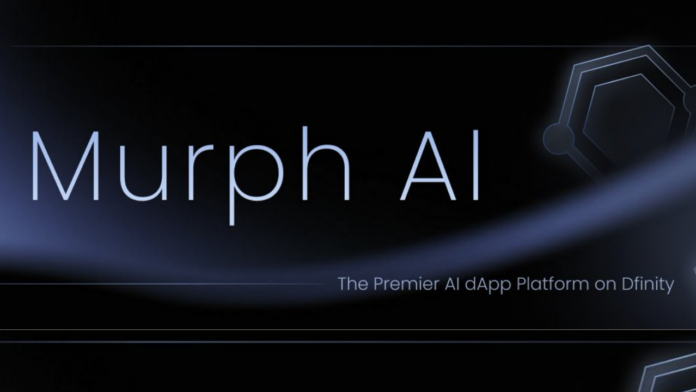Murph AI is looking to shake up the AI space on Web3 by making machine learning infrastructure feel less like an exclusive club and more like a public park. The team behind the project is building what they describe as a modular, scalable AI network on the Internet Computer Protocol (ICP), with an emphasis on usability and incentives for contributors.
Instead of simply providing machine learning services or tools for developers, Murph AI is aiming to give users the chance to contribute to AI workflows and earn for doing so. At the heart of the offering is what they call an “AI-driven infrastructure” and a “using-AI-to-earn” model that fits neatly into ICP’s decentralised architecture.
The project’s aim is to demystify and decentralise how AI systems are trained and deployed. Murph AI says it is designing a network where compute tasks can be broken down into modules, distributed, and scaled up or down depending on what’s needed—whether it’s a casual user contributing GPU power or a developer looking to run a large model. The infrastructure relies on ICP’s ability to run backend logic on-chain without needing traditional cloud providers, which helps to keep things decentralised and, in theory, more open.
One of Murph AI’s main selling points is the way it connects contribution to reward. By allowing users to take part in the training and fine-tuning of AI models, the system is structured to compensate those users in return. The team hasn’t publicly laid out the full tokenomics yet, but the pitch focuses on creating a sustainable incentive loop, where people benefit directly from the growth and use of the AI they help power.
The “using-AI-to-earn” phrase is catchy, but what it describes is a process that blends the mechanical with the economic. Users might run prompts, feed in data, validate outputs, or provide computing power, and each action is logged, tracked and credited. Over time, this could make Murph AI more community-run than the usual AI infrastructure offerings, which tend to be closed-source, centrally hosted, and dominated by major cloud providers.
Integration with ICP is a key part of how this system is expected to work. Rather than offloading compute or data storage to separate systems, Murph AI keeps everything within the Internet Computer’s ecosystem. That’s not just about branding—it’s also about how decentralised computation is coordinated. The canisters (smart contracts) on ICP allow for persistent data and logic, meaning that training histories, user contributions, and inference records can all live on-chain. This ties into the transparency angle: everything is verifiable and auditable, including where compute happened and what it produced.
For those familiar with AI tooling but not ICP, the move might take some adjusting. ICP’s model is quite different from Ethereum or Solana in how it structures computation. Where others often push AI workloads off-chain to maintain speed, Murph AI is betting that ICP’s native compute abilities are strong enough to keep everything under one roof. This approach is more attractive to users who value openness and who prefer to avoid dependencies on platforms like AWS or Google Cloud.
The “modular” part of Murph AI’s message refers to how the system handles workflows. Instead of one giant model doing everything, the idea is to have smaller components that handle specific tasks. These can then be pieced together into pipelines, reused, or improved without needing to rebuild the whole system. This modularity could make the network more adaptable and let it evolve faster. It also lowers the entry barrier for developers or contributors who want to work on a single part of a larger system.
One of the other goals of Murph AI is to create a shared layer where AI applications can be deployed and monetised without relying on Web2 services. The team talks about enabling new kinds of Web3 apps that are more intelligent, from chatbots and recommendation engines to smart automation tools. But unlike traditional software where developers shoulder all the cost, here the resource load is distributed and contributors are rewarded, creating what they hope will be a self-sustaining cycle.
There are plenty of buzzwords floating around AI and crypto at the moment, but Murph AI is trying to build something grounded in working infrastructure and real user engagement. That means focusing less on hype and more on actually running models in a decentralised way, letting people earn for helping out, and making the tech easier to integrate into everyday apps.
Of course, it’s still early days. Like many projects that blend AI with blockchain, Murph AI has more ambition than track record at the moment. But the focus on rewarding contributors directly and using ICP’s native tools gives it a clearer framework than some AI-in-Web3 projects that have struggled to move beyond demo stage. By tying rewards to actual inputs and outputs, and keeping the whole thing on-chain, the project hopes to avoid the pitfalls that come with outsourcing core infrastructure.
The Telegram channel for Murph AI is now open, and users are being encouraged to join, connect their wallets, and follow updates. The official website also features an overview of the concept and its roadmap, though some details—especially around token distribution and governance—are still to come.
Murph AI is stepping into a fast-moving space, but its bet is on turning the infrastructure itself into the playground. It’s not just about flashy AI demos or trading on the buzz of machine learning—it’s about building a system where the community gets a stake in the underlying tools that power it all.
The idea that AI infrastructure can be decentralised, modular and rewarding isn’t new, but Murph AI’s take leans on ICP’s strengths and puts contributors front and centre. If it works as intended, it could help shift more AI development into open networks where people can participate, earn, and build smarter systems together—without needing to rent time from tech giants. Whether that’s enough to make it stand out long-term will depend on how smoothly the system runs and how attractive the rewards actually are.
For now, the message is clear: if you’ve got compute, data, or curiosity to spare, there’s a new machine learning project waiting for you on ICP—and it might even pay you for it.


